Cardiology Patient Stories

August 20, 2023
Red meat and high-starch foods like mashed potatoes were the family fare while Stephanie Blendermann was growing up in Long Island, New York. Her father[...]

February 18, 2013

December 12, 2012

December 8, 2012

December 8, 2012

December 2, 2012

December 1, 2012

November 24, 2012

November 23, 2012

November 22, 2012

September 18, 2012

May 1, 2012
Explore more topics
 Sign up
Sign up

Mayo Clinic Connect
An online patient support community
